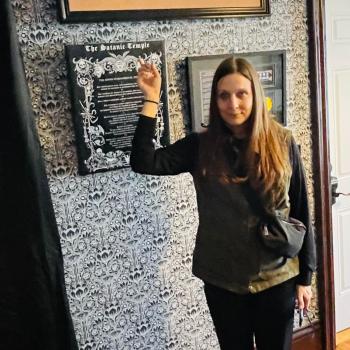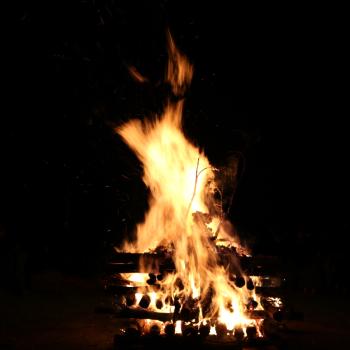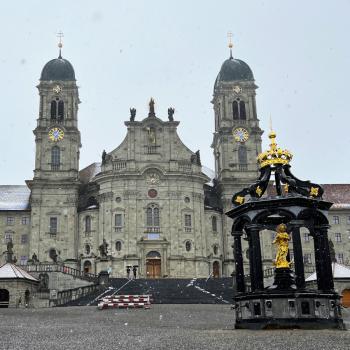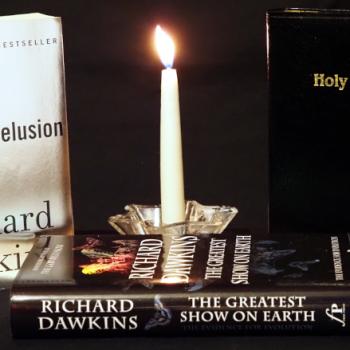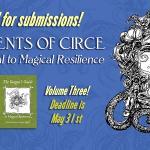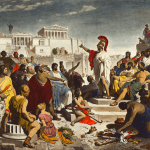I love Thanksgiving. What’s not to love about a holiday devoted to food, family, friends, and football? On a deeper level, it’s good to have a day for acknowledging the good things in our lives that didn’t have to be but are and saying “thank you!”
Like many others, I’m not happy about retailers opening on Thanksgiving. I had a retail job in high school and Cathy worked retail until a few years ago. We worked a lot of days we didn’t want to work, but we knew we could count on spending Thanksgiving with our families. Now that’s being taken away from thousands of retail workers – people who are generally the lowest paid and most vulnerable in our workforce.
Who’s to blame? What’s to blame? More importantly, what can we do about it?
Politicians grab votes and commentators grab ratings by blaming scapegoats and giving oversimplified answers. I think this issue deserves a closer look.
The Cold War
 Those of us who lived through the Cold War remember the arms race: the long and expensive chase to make sure that whatever weapons the Soviet Union had, we had bigger better newer more. Submarines, aircraft carriers, long range bombers, fighter jets, tanks, rifles, and even pistols had to be constantly updated.
Those of us who lived through the Cold War remember the arms race: the long and expensive chase to make sure that whatever weapons the Soviet Union had, we had bigger better newer more. Submarines, aircraft carriers, long range bombers, fighter jets, tanks, rifles, and even pistols had to be constantly updated.
The core of the arms race, though, centered around intercontinental ballistic missiles and their nuclear warheads. Our defense strategy was “mutually assured destruction” or MAD, which is surely the most appropriate acronym ever devised.
Sensible heads on both sides recognized the madness of MAD and the Strategic Arms Limitation Talks began in 1969. Several treaties were negotiated, but significant disarmament (and the reallocation of resources it would have permitted) never happened. Some assumed the Soviets wouldn’t honor their agreements, but others didn’t want peaceful coexistence. They wanted to crush what they saw as an “evil empire.”
Conservative mythology says Ronald Reagan’s acceleration of the arms race bankrupted the Soviet Union. That’s yet another oversimplification, and those who promote that mythology usually ignore the impact the arms race had on the national debt they claim is ruining the country. For our purposes here it’s enough to point out a basic fact: trying to stay ahead of an enemy is a race with no finish line. No one can win, but no one feels safe dropping out.
Why do trees grow tall? Growing and supporting a long trunk takes resources, and all the trunk accomplishes is connecting the roots with the leaves. But a long trunk also raises the leaves high in the air where they have unimpeded access to sunlight. Taller plants had an advantage over shorter plants, and over hundreds of millions of years of evolution, competition for sunlight resulted in tall trees.
Gazelles run fast because cheetahs run faster. Over millions of years of evolution, slower gazelles have been removed from the gene pool by cheetahs, and slower cheetahs have been removed from the gene pool by starvation. This is a brutal process, but no gazelle is going to say “you guys can stop trying to run faster – I’ll just let the cheetahs eat me.”
The Retail Arms Race
The retail business is every bit as competitive and every bit as vicious as life on the savannah. We have far more retailers than we need and every one is fighting first for survival, then for profits, then to put competitors out of business. Fixed costs are high and working capital is tied up in merchandise they hope you’ll buy. Gross margins (the difference between purchase price and selling price) are high (especially with luxury and fashion items), but net margins (after overhead and other expenses are deducted) can be very low.
As in the natural world, the retail world has experienced extinctions: Woolworth, Montgomery Ward, Circuit City, and a host of regional and independent stores. It has endangered species: K-Mart, Sears, and Best Buy, just to name a few. A retailer stumbling in the marketplace faces the same fate as a gazelle stumbling in the wild.
The Logic of Black Friday
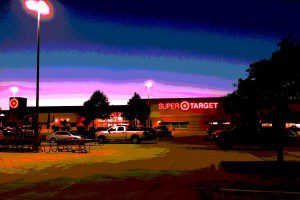 Black Friday is so called because a good sales day on the Friday after Thanksgiving can make the difference between finishing the year in the black (with a profit) or in the red (with a loss). Trillions of dollars are spent during the Christmas season and retailers are fighting to get as many of them as they can for themselves.
Black Friday is so called because a good sales day on the Friday after Thanksgiving can make the difference between finishing the year in the black (with a profit) or in the red (with a loss). Trillions of dollars are spent during the Christmas season and retailers are fighting to get as many of them as they can for themselves.
And they want to get those dollars as soon as they can. If you buy the hot new toy at Wal-Mart, you won’t buy it from anyone else. And if you buy early enough, you may go back and buy more even though you really can’t afford it. Retailers have a strong incentive to get you to buy early.
This has brought us the Thanksgiving Arms Race. First there were Black Friday sales. Then there were 8AM sales, then 6AM sales, then midnight sales. Then some stores started opening on Thanksgiving evening. This year more will open Thursday evening, and some will open Thursday morning.
Perhaps retailers could negotiate their own SALT treaty and agree on a common opening time (assuming that wouldn’t be considered collusion), but on-line retailers are always open.
The 24/7 Consumer Society
My parents said when they were growing up in the 1930s and 40s “they rolled up the sidewalks at 5:00.” There may have been some parental exaggeration there, but I remember when everything was closed on Sundays. I remember when everything was closed on Thanksgiving, and also Christmas, New Year’s Day, and Easter.
Then convenience stores and gas stations started staying open. Then grocery stores. Then movie theaters. There have always been a few restaurants open on holidays, but now it’s more. Hospitals, of course, never close, and first responders are always on call. The Monday through Friday, morning through afternoon, all holidays off routine we learn in school simply doesn’t exist for many people.
Thanksgiving shopping is the next evolutionary step in the development of the 24/7 consumer society.
Refusing to shop on Thanksgiving is a good start, but it’s a drop in the bucket of the real problem. We want more stuff. Retailers and their investors want more profits. And plenty of ordinary people need jobs – even low-paying retail jobs – because without a job the odds on avoiding poverty drop dramatically.
Not Sustainable
Our consumer society is not sustainable. It’s built on cheap oil, and the current low prices are a short term market adjustment, not a change in long term realities. The oil is running out, and whether we run out in 20 years or 50 years or 100 years, we will run out – to say nothing of the environmental damage and related costs caused by climate change. We are at the beginning of a long descent. How far and how fast we fall remains to be seen, but fall we will.
How can we move to something that is sustainable?
First, understand that a kinder, gentler consumer society isn’t possible. The consumer society is based on the idea that more is always better, and that idea lies at the core of the Thanksgiving Arms Race and many of our social, economic, and political ills.
I’m a Pagan and not a Catholic, but I’m in strong agreement with this quote from Pope Francis:
We have created new idols. The worship of the ancient golden calf has returned in a new and ruthless guise in the idolatry of money and the dictatorship of an impersonal economy lacking a truly human purpose. The worldwide crisis affecting finance and the economy lays bare their imbalances and, above all, their lack of real concern for human beings; man is reduced to one of his needs alone: consumption.
Pope Francis identifies the core problem of the Western economic system – the idea that the value of everything is simply what someone is willing to pay for it. We treat people like commodities whose only value is what economic benefit they can produce, who can be used until they’re no longer profitable and then discarded.
Not Just Better, But Different
We can behave like politicians and their mouthpieces on talk radio, blaming scapegoats and advocating superficial solutions to complex problems. Or we can do the hard but necessary work of building a society that’s not just marginally better, but qualitatively different.
A different society needs different values. It needs less competition and more cooperation. It needs less stuff – a lot less stuff – and more time. Fewer malls and more parks. Smaller houses, smaller lawns, and bigger gardens.
A truly different society would see Nature as something sacred and with value intrinsic to itself, not as a “resource” to be exploited for human greed.
A different society begins with a commitment to Nature.
This change won’t be easy and it certainly won’t be quick. It will not be fully realized in my lifetime, nor likely in yours. But if we start now, promoting different values and demonstrating a different way to live, we can build a world where the Thanksgiving Arms Race is a relic on the ash heap of history.







